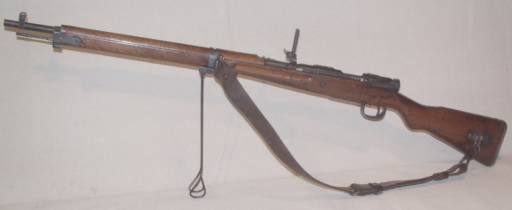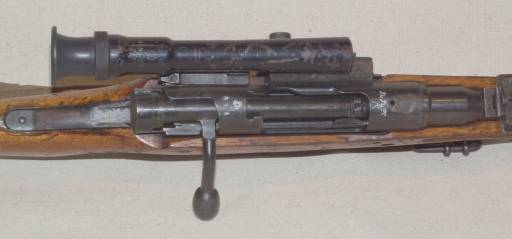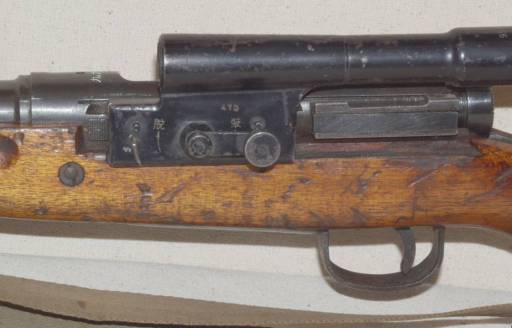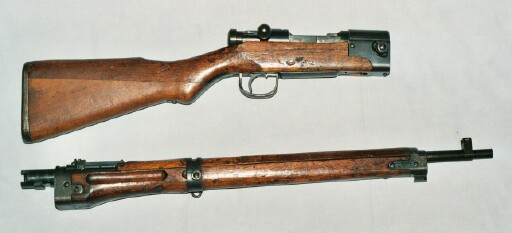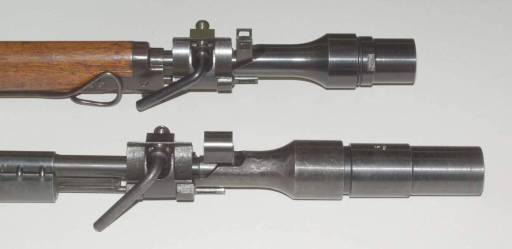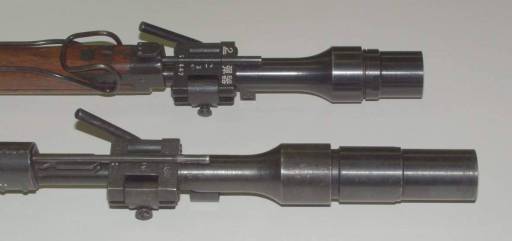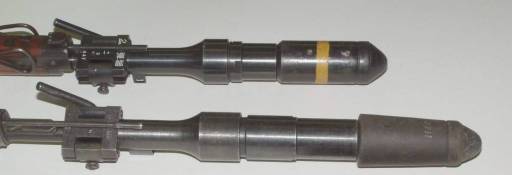In 1938
guidelines were established for the development of a 7.7mm rifle.
Experience gained in China indicated that a larger caliber than the 6.5mm
was needed. Initially, about 300 Type 38 rifles were converted to
7.7mm. After testing these rifles, the decision was made to design
a new rifle instead of just converting the Type 38 to 7.7mm.
Type 99
Long Rifle.
Long rifle
& short rifle monopods.
Long rifle
& short rifle aircraft sights.
The resulting
rifle was adopted as the Type 99 in 1939. Initial production was
a long rifle similar to the Type 38 but in 7.7X58 caliber. The long
rifle had a longer monopod under the stock, a different monopod hinge &
the aircraft sights (designed for the soldier to lead flying aircraft)
were different, having 2 sight notches both on the bottom & the top
of the sight arms instead of only one on the bottom as on the later short
rifles version.
The Japanese found
that little change in accuracy was apparent between long rifle and short
rifle designs. Consequently, they quickly changed to a short rifle
design. As the war continued the Type 99 went through a continuing
series of modifications to make it easier to produce & conserve materials.
This ended with the so called Last Ditch rifles that are extremely crude
with wooden butt plates. The terms First Production, Mid War Production
& Late War Production under the photos are used as general terms.
Changes were incorporated at different times by different manufacturers
& there is a great variety of what changes can be found in any Type
99 rifle.
First production
Type 99 no series rifle with aircraft sights, monopod, front sight protector
ears & excellent workmanship.
Mid war
production. It has an adjustable rear sight without aircraft arms, no monopod
or front sight protector.
Late war
production. Fixed rear sight, welded safety knob, cylindrical bolt
handle & wooden butt plate. This version was adopted by the Japanese
as the “Substitute Type 99”.
The Japanese
never officially adopted a sniper rifle based on the Type 99. They
did equip the Type 99 with a telescopic sight, both 2.5 power & 4 power.
These rifles are identified only as Type 99 sniper’s rifles.
There were
2 paratroop rifle versions of the Type 99 produced. The first was
the Type 100. It had an interrupted screw barrel thread. Very
few were produced. The second was the Type 2. It had a sliding wedge
system to lock the barrel in place. The wedge slides in front of
the lug on the rear of the barrel & is threaded into the side of the
receiver. It has a wire bail to hand tighten it.
Early Type
99 Naval Special with hand guard, front sight protector ears & adjustable
rear sight.
Late
Naval Special with no hand guard, no front sight ears & fixed rear
sight.
Early rifle
Late rifle.
Late carbine.
Early rifle.
Late
rifle.
Late
carbine.
The Japanese
Navy manufactured a version of the Type 99 with a cast iron receiver.
This was the Naval Special Type 99 Rifle. A 26 9/16” barreled rifle
& 21 5/8” carbine were produced. Although crude, the first rifles
had upper hand guards & receiver markings. The late war ones
had no receiver markings other than a S/N & an inspection mark.
Apparently none of the guns were blued. They were all painted, mostly
black but some may have red painted parts mixed in.
Not only the receiver
but all the bands, trigger guard & magazine floor plate were cast iron.
The chamber of the barrel was enlarged & the locking recess for the
bolt was machined into the barrel. This kept the receiver from carrying
any of the stresses of firing. Even though this is sound in theory
& is used on some modern rifles, these cast iron receiver rifles &
carbines should not be fired!
The Japanese used
a wide variety of training rifles. Most of these were crudely made
in small shops. Stocks were generally made of one piece of wood instead
of the normal dove tailed 2. Barrels were smoothbore (no rifling)
as they were designed to only fire blanks. The majority were styled
after the Type 38 long rifle. The navy had one with a cast iron receiver
that was styled after the Type 99 short rifle. In addition, obsolete
Japanese & captured enemy rifles were converted into trainers.
Schools that had access to ranges were issued serviceable Type 30 &
38 rifles that usually had the school markings on the stock or the character
for school stamped on the breech ring.
Izawa 38
Model Youth Training Gun No. 2 that used a straight walled pistol type
blank cartridge to simulate firing.
A naval
Type 99 trainer with a cast iron receiver.
A Type
99 long rifle trainer. The second photo shows the fore stock &
front band/bayonet lug of both the trainer & a Type 99 long rifle.
The Type 38 trainers have a rounded band similar to the Type 38 rifles.
A Japanese
trainer made from a captured Chinese M1888 rifle.
One additional
Japanese rifle that is fairly common is the so-called Type I, (I think
for Italy). In 1937 the 3 Axis Powers (Germany, Italy & Japan)
signed an agreement for the exchange of industrial help. Japan needed
additional rifles to equip her growing military, so she placed an order
with the Italian Government for 60,000 rifles. These all used the
Italian Carcano action but with all components copied from the Japanese
Type 38 rifle, including the Mauser style magazine & 2 piece stock.
Production started in 1938 & was completed in 1939. It is reported
that the entire production was delivered to the Imperial Japanese Navy.
Japan got
a late start on adopting a rifle grenade launcher. In the late 1930s
they adopted a spigot type launcher that used the Type 91 hand grenade
with a special hollow finned shaft in stead of the booster assembly used
in the Type 89 Grenade Launcher (so called Knee Mortar). In 1940
they adopted the Type 100 cup type launcher that fired the Type 99 Kiska
grenade. In 1942 2 German officers went to Japan with examples of
the German cup type hollow charge grenade launcher. After a short
evaluation & some changes, the German design was adopted as the Type
2. The photos show both the Japanese & German versions of this
launcher.
I’d like to thank
John Ziorbo for supplying the pictures of the Type 1 Test carbine, Type
97 & 99 sniper rifles & the Type 99 Naval Special early rifle &
carbine & the Type 2 rifle grenade launcher. Also Francis
C. Allan & Harvey W. Macy (Deceased) for the information in BANZAI
Special Project #8, The Type 38 Arisaka.
copyright
2004
Carbines
for Collectors
Cliff
Carlisle
|
